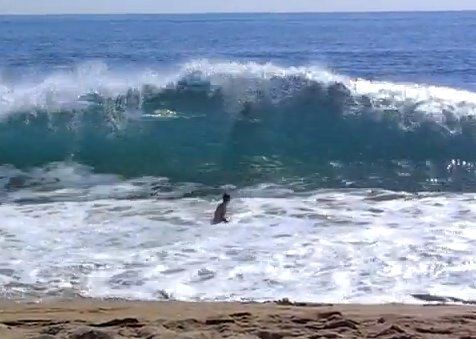
Harvard and Yale researchers found that the average U.S. citizen was willing to pay $162 a year more to support a national policy requiring 80 percent 'clean' energies by 2035. Nationwide that would represent a 13 percent increase in electric bills.
Respondents categorically defined 'clean' as not including natural gas or nuclear power energies. Rather they favored solar, wind, geothermal and, in the very near future, ocean wave farms.
Worldwide ocean waves provide up to 2 terawatts of instantaneous electricity (1 terawatt equals 1 trillion watts), which is twice the electricity generating capacity currently consumed on planet Earth.
Imagine this wondrous constant ebb and flow of the ocean or an energy-generating source just waiting to be harnessed. And then think of all the green jobs made in America that ocean wave technologies will support.
Entrepreneurs, engineers, physicists, oceanographers and now eager investors are getting behind some truly innovative technologies that are powering homes, factories, universities and hospitals.
Fathom this: wave technology is reducing greenhouse gases and moving society beyond the climate-altering, deleterious fossil fuels.
Over 50 wave technology companies around the globe are using almost 60 years of experience with deep-sea oil platforms as they hurry to deploy wave farms. There are currently more than half a dozen, wave farms generating electricity in Europe and Australia. And at least another dozen -- much larger farms -- will be operational within 24 months.
As any mariner, deep-sea oil driller, rig worker or boat enthusiast knows, the ocean and its environment are rugged and unforgiving.
Wave farms are being located between one and three miles from the shoreline. Utility companies are examining the sea floor, looking for strong wave climates or big consistent waves packed with power. Alaska, British Columbia, Washington, Oregon and California have hundreds of such strong wave climates. Already, Newport Beach entrepreneurs behind Green Wave Energy Corp. are testing ocean wave-powered turbines near the Wedge -- a legendary Southern Californian bodysurfer destination.
Today, utility companies in California must source 20 percent of their energy from non-fossil fuel technology, and by 2020 they must increase that stake to 33 percent.
Europe has farms positioned off Portugal and Spain with British and Scottish farms under construction. European Union laws require greenhouse gas reductions by 20 percent, beneath the 1990 levels, by 2020.
In Europe, a number of governments have provided substantial funding for wave technologies; as a result, Britain will be the first nation to have a large-scale wave farm operational, shortly.
Wave machines must be resilient enough to survive monster waves and gale force winds at sea. Farms are either anchored to the ocean floor with heavy chains or locked in place with huge concrete and steel piles.
Human ingenuity has created at least four marvelous variations of machines outfitted with turbines and pistons, all with a common goal of capturing the energy of ocean waves and turning it into green electricity.
Scottish engineer and avid seaman Dr. Richard Yemm designed the Pelamis attenuator. It resembles red floating missiles, and this 492-foot-long tube of hollow steel is hinged in three places.
Unlike all the other wave technologies, seawater never comes into direct contact with its turbines (which spin to create electricity); the attenuator mechanics are housed in a sealed joint. As the attenuator bobs in the sea its hydraulic pistons compress, creating energy.
The Wave Dragon is the brainchild of Dane Erik Friis-Madsen. His inspiration came from observing ocean water as it passed through openings in Pacific atolls -- extinct volcanoes just beneath the ocean surface. This 328 foot-long floating barge has two outstretched concrete and steel wings, which contain damming reservoirs. The Wave Dragon mimics an underwater volcano, as waves are pushed up and over a ramp into a man-made lagoon or reservoir. Captured water drains out, passing through about 18 openings outfitted with turbines that create electricity.
The yellow Aquabuoy point absorber was created by a Swedish team lead by Gunnar Fredrikson. The point absorber has a 13-foot-diameter cylinder that occupies a series of pumps that push seawater up the tube and through the turbine mounted at the top. As the seawater retreats the turbine continues to spin.
The Oscillating water column was invented by Australian Tom Denniss, and at first glance it appears like a device straight out of a Dr. Seuss book.
Denniss built this wave farm to mimic the Kiama Blowhole, a 98-foot tall New South Wales (Australia) geyser that shoots from an opening in the ceiling of a sea cave. As waves enter his man-made steel blowhole through a narrow opening at its submerged base, air is pushed through a hole outfitted with a turbine, which spins under pressure. As the waves recede out of the blowhole air is sucked back in the hole also causing the turbine to spin.
These are very exciting, innovative times with Google's multi-billion investment in offshore northeast wind farms. The ocean wave technology race is well underway for each of these magnificent designs and many others to generate jobs and renewable, green electricity. There are no problems that the fertile human mind cannot overcome.
Earth Dr. Reese Halter is an award-winning broadcaster and distinguished biologist. His latest books are: The Incomparable Honeybee and The Insatiable Bark Beetle.
